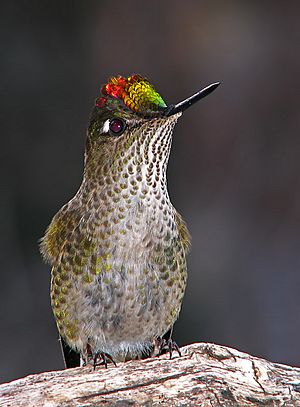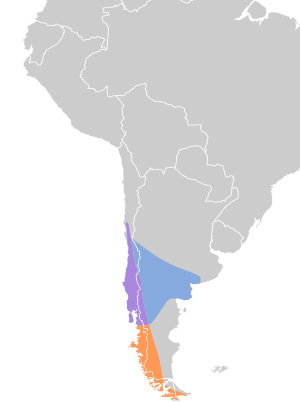Green-backed firecrown facts for kids
Quick facts for kids Green-backed firecrown |
|
|---|---|
 |
|
| Conservation status | |
| Scientific classification | |
| Genus: |
Sephanoides
|
| Species: |
sephaniodes
|
 |
|
The green-backed firecrown (Sephanoides sephaniodes) is a beautiful hummingbird. You can find this tiny bird in Argentina, mainland Chile, and on the Juan Fernández Islands. It's known for its bright colors and quick movements.
Contents
What Kind of Bird Is It?
The green-backed firecrown is a special type of hummingbird. It's the only bird in its group, or genus, besides the Juan Fernandez firecrown. Think of it like a family tree where these two birds are very close relatives!
What Does It Look Like?
The green-backed firecrown is a small bird, about 10 to 10.5 centimeters (4 inches) long. Males weigh about 5.5 grams (0.2 ounces), and females are a bit lighter, around 5 grams.
Boys and girls of this species look a little different:
- Males are usually a bit bigger and have shorter beaks. They have a shiny, bright red-yellow crown on their heads. This is where they get the "firecrown" part of their name!
- Females are smaller with longer beaks. They don't have the bright crown.
Both male and female adults have shiny green feathers on their backs. Their wings and tails are a dark, slaty green. Their bellies are pale yellow with some black and green spots. Young birds have rusty edges on their head feathers and a cinnamon color on their undersides.
Where Does It Live?
You can find the green-backed firecrown in many parts of Chile, from the middle of the country all the way to the very south. It also lives in nearby areas of southern Argentina and stretches east to the Atlantic coast.
There's also a group of these birds living far out in the ocean on the Robinson Crusoe and Alejandro Selkirk Islands. These islands are about 770 kilometers (478 miles) off the coast of Chile. Sometimes, a few birds even fly as far as the Falkland Islands!
These hummingbirds like to live in places like:
- Edges of forests
- Plantations of Eucalyptus trees
- Open clearings
- Thick bushes
- Gardens
They are very important for the environment because they help pollinate plants in the rainforests of South America. You can find them from sea level up to high mountains, over 2,000 meters (6,500 feet) high.
How Does It Behave?
Movement
Some green-backed firecrowns stay in one place all year, especially those on the Juan Fernandez Islands. Others move around. Birds living in central Chile and western Argentina stay there year-round.
However, birds that nest in the very south of Chile and Argentina will fly to the lowlands of central Argentina for the winter. Some even go as far east as the Atlantic coast!
Feeding Habits
The green-backed firecrown loves to drink nectar from many different kinds of flowers. They especially like flowers from plants like Abutilon, Embothrium, and Fuchsia. Sometimes, they will sit on a flower to drink nectar instead of hovering in the air.
These clever birds can remember where the best nectar is, even among many similar flowers. They are also very protective of their feeding spots. They have been seen chasing away other birds, even large ones like caracaras!
Reproduction and Life Cycle
On the mainland, green-backed firecrowns build their nests and lay eggs from September to November. On the Juan Fernández Islands, their nesting season seems to be from September to December.
Their nest is a very small cup, and sometimes they build it right above water. The female lays two white eggs. We don't know much more about how they raise their young.
Sounds and Calls
The green-backed firecrown has a special song. It's a series of high-pitched notes mixed with gravelly trills and squeaky sounds. It might sound like "pseee...pseee...krrr.skee.skee.skee....psee..."
Their regular call is a single "psee" or "skee."
What Is Its Status?
The IUCN (International Union for Conservation of Nature) says the green-backed firecrown is a species of "Least Concern." This means they are not currently in danger of disappearing.
Even though we don't know exactly how many there are, and their numbers might be slowly decreasing, they are still common in many places. They do well even in areas changed by humans, like city parks and gardens. On the Juan Fernandez Islands, there are believed to be about 5,000 of these birds. They also live in several protected areas on the mainland. No major threats have been found for them right now.
See also
 In Spanish: Picaflor para niños
In Spanish: Picaflor para niños


